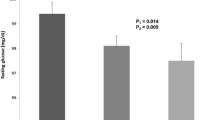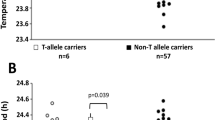Abstract
Homocysteine (Hcy) is known to be a prognostic marker for neurological, cardiovascular and cerebrovascular diseases and several other pathophysiological conditions. A sudden surge in Hcy can increase cardiovascular events. Hemodynamic modulations are known to be associated with individual’s chronotype. Therefore, precise monitoring of Hcy is crucial for evaluating its impact on risk. The aim of the present study was to investigate the rhythmicity of Hcy under controlled dietary conditions and whether this rhythmicity is under the genetic control of circadian rhythm. Five subjects were selected from 200 Malayalam speaking healthy ethnic individuals who were screened for functionally critical variants of MTHFR and hCLOCK genes. MTHFR is the rate-limiting enzyme in the methionine cycle and critical for regulating Hcy levels while hCLOCK is a critical gene responsible in regulating the day and night cycles. Rhythmicity in Hcy levels were observed in all the subjects with a consensus on a morning nadir and an evening peak. Gender specific stratification of Hcy levels were observed among similar genotypes of MTHFR and hCLOCK genes. Variations from the conventional rhythmicity of Hcy were observed among similar genotypes of MTHFR and dissimilar hCLOCK genotypes. A reduced plasma Hcy in hCLOCK rs1801260 CC genotype individuals were observed in contrast to CT genotype individuals. The study tends to suggest that Hcy and body time are genetically interdependent and throws light on some of the previously unexplained reasons for variability in Hcy levels. A population specific variation of MTHFR and hCLOCK genes also highlights ethnicity specific risk management.




Similar content being viewed by others
References
Schalinske KL, Smazal AL (2012) Homocysteine imbalance: a pathological metabolic marker. Adv Nutr 3:755–762
Bostom AG, Shemin D, Verhoef P, Nadeau MR, Jacques PF, Selhub J et al (1997) Elevated fasting total plasma homocysteine levels and cardiovascular disease outcomes in maintenance dialysis patients. A prospective study. Arterioscler Thromb Vasc Biol 17:2554–2558
Selhub J (1999) Homocysteine metabolism. Ann Rev Nutr 19:217–246
Tanaka T, Scheet P, Giusti B, Bandinelli S, Piras MG, Usala G et al (2009) Genome-wide association study of vitamin B6, vitamin B12, folate, and homocysteine blood concentrations. Am J Hum Genet 84:477–482
Kang SS, Wong PW, Susmano A, Sora J, Norusis M, Ruggie N (1991) Thermolabile methylene tetrahydrofolate reductase: an inherited risk factor for coronary artery disease. Am J Hum Genet 48:536–545
Castro R, Rivera I, Ravasco P, Jakobs C, Blom HJ, Camilo ME et al (2003) 5, 10-Methylenetetrahydrofolate reductase 677CT and 1298AC mutations are genetic determinants of elevated homocysteine. Q J Med 96:297–303
Panagiotakos DB, Pitsavos C, Zeimbekis A, Chrysohoou C, Stefanadis C (2005) The association between lifestyle-related factors and plasma homocysteine levels in healthy individuals from the “ATTICA” Study. Int J Cardiol 98:471–477
Urgert R, van Vliet T, Zock PL, Katan MB (2000) Heavy coffee consumption and plasma homocysteine: a randomized controlled trial in healthy volunteers. Am J Clin Nutr 72:1107–1110
Halsted CH (2001) Lifestyle effects on homocysteine and an alcohol paradox. Am J Clin Nutr 73:501–502
Qiao SD, Liu N, Fan DS, Gao XH, Zhou JW (2008) Relationship between smoking and homocysteine concentration in ischemic stroke patients. Zhonghua Yi Xue Za Zhi 88:3342–3344
Katzenberg D, Young T, Finn L, Lin L, King DP, Takahashi JS et al (1998) CLOCK polymorphism associated with human diurnal preference. Sleep 21:569–576
Kuo K, Still R, Cale S, McDowell I (1997) Standardization (external and internal) of HPLC assay for plasma homocysteine. Clin Chem 43:1653–1655
Frick B, Schröcksnadel K, Neurauter G, Wirleitner B, Artner-Dworzak E, Fuchs D (2003) Rapid measurement of total plasma homocysteine by HPLC. Clin Chim Acta 331:19–23
Sambrook J, Fritsch EF, Maniatis T (1989) Molecular cloning, a laboratory manual, 2nd edn. Cold Spring Harbor Laboratory, NewYork
Cappuccio FP, Bell R, Perry IJ, Gilg J, Ueland PM, Refsum H et al (2002) Homocysteine levels in men and women of different ethnic and cultural background living in England. Atherosclerosis 164:95–102
Adachi H, Hirai Y, Fujiura Y, Matsuoka H, Satoh A, Imaizumi T (2002) Plasma homocysteine levels and atherosclerosis in Japan: epidemiological study by use of carotid ultrasonography. Stroke 33:2177–2181
Golbahar J, Rezaian G, Bararpour H (2004) Distribution of plasma total homocysteine concentrations in the healthy Iranians. Clin Biochem 37:149–151
Rasmussen K, Møller J, Lyngbak M, Pedersen AM, Dybkjaer L (1996) Age- and gender-specific reference intervals for total homocysteine and methylmalonic acid in plasma before and after vitamin supplementation. Clin Chem 42:630–636
Sibani S, Christensen B, O’Ferrall E, Saadi I, Hiou-Tim F, Rosenblatt DS et al (2000) Characterization of six novel mutations in the methylene tetra hydro folate reductase (MTHFR) gene in patients with homocystinuria. Hum Mutat 15:280–287
Lavie L, Lavie P (2004) Daily rhythms in plasma levels of homocysteine. J. Circadian Rhythms 2:5
McClung CA (2007) Circadian genes, rhythms and the biology of mood disorders. Pharmacol Ther 114:222–232
Panda S, Antoch MP, Miller BH, Su AI, Schook AB, Straume M et al (2002) Coordinated transcription of key pathways in the mouse by the circadian clock. Cell 109:307–320
Oishi K, Miyazaki K, Kadota K, Kikuno R, Nagase T, Atsumi G et al (2003) Genome-wide expression analysis of mouse liver reveals CLOCK-regulated circadian output genes. J Biol Chem 278:41519–41527
Dankner R, Chetrit A, Dror GK, Sela BA (2007) Physical activity is inversely associated with total homocysteine levels, independent of C677T MTHFR genotype and plasma B vitamins. Age (Dordr) 29:219–227
Bass J, Takahashi JS (2010) Circadian integration of metabolism and energetics. Science 330:1349–1354
Minami Y, Kasukawa T, Kakazu Y et al (2009) Measurement of internal body time by blood metabolomics. PNAS 106:24
Obeid R, Herrmann W (2006) Mechanisms of homocysteine neurotoxicity in neuro-degenerative diseases with special reference to dementia. FEBS Lett 580:2994–3005
Lavie L, Perelman A, Lavie P (2001) Plasma homocysteine levels in obstructive sleep apnea. Chest 120:900–908
Ma Y, Zhao X, Zhang W, Liu L, Wang Y, Fang R et al (2010) Homocysteine and ischemic stroke subtype: a relationship study in Chinese patients. Neurol Res 32:636–641
Muntjewerff JW, Kahn RS, Blom HJ, den Heijer M (2006) Homocysteine, methylene tetrahydro folate reductase and risk of schizophrenia: a meta-analysis. Mol Psychiatry 11:143–149
Kawakami C, Ohshige K, Tochikubo O (2008) Circadian variation in cardiovascular emergencies among the elderly. Clin Exp Hypertens 30:23–31
Peres I, Vetter C, Blautzik J, Reiser M, Pöppel E, Meindl T et al (2011) Chronotype predicts activity patterns in the neural underpinnings of the motor system during the day. Chronobiol Int 28:883–889
Tawakol A, Forgione MA, Stuehlinger M, Alpert NM, Cooke JP, Loscalzo J et al (2002) Homocysteine impairs coronary microvascular dilator function in humans. J Am Coll Cardiol 40:1051–1058
Martins PJ, D’Almeida V, Vergani N, Perez AB, Tufik S (2003) Increased plasma homocysteine levels in shift working bus drivers. Occup Environ Med 60:662–666
Hankey GJ, Eikelboom JW (2001) Homocysteine and stroke. Curr Opin Neurol 14:95–102
Nestel PJ, Chronopoulos A, Cehun M (2003) Arterial stiffness is rapidly induced by raising the plasma homocysteine concentration with methionine. Atherosclerosis 171:83–86
Levi F, Zidani R, Misset JL (1997) Randomised multicentre trial of chronotherapy with oxaliplatin, fluorouracil, and folinic acid in metastatic colorectal cancer. International organization for cancer chronotherapy. Lancet 350:681–686
Kasukawa T, Sugimoto M, Hida A, Minami Y, Mori M, Honma S et al (2012) Human blood metabolite timetable indicates internal body time. Proc Natl Acad Sci USA 10:15036–15041
Urbán R, Magyaródi T, Rigó A (2011) Morningness–eveningness, chronotypes and health-impairing behaviors in adolescents. Chronobiol Int 28:238–247
Acknowledgments
We thank all the participants who voluntarily consented for the study.
Disclosure
Authors have nothing to disclose.
Author information
Authors and Affiliations
Corresponding author
Rights and permissions
About this article
Cite this article
Paul, B., Saradalekshmi, K.R., Alex, A.M. et al. Circadian rhythm of homocysteine is hCLOCK genotype dependent. Mol Biol Rep 41, 3597–3602 (2014). https://doi.org/10.1007/s11033-014-3223-5
Received:
Accepted:
Published:
Issue Date:
DOI: https://doi.org/10.1007/s11033-014-3223-5




